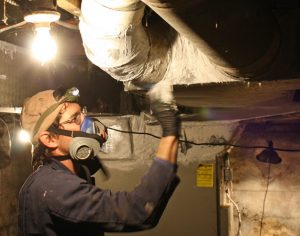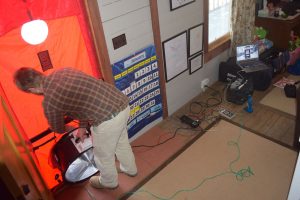Front Porch Blog
This post was co-authored by North Carolina Energy Savings Outreach Coordinator Amber Moodie-Dyer.

Will Haddaway, owner of HomEfficient, seals Blue Ridge Electric member Vance Woodie’s leaky air ducts before insulating them.
As advocates and organizers working to solve big problems, we often forget to celebrate the incremental success of our campaigns and jump right into the next problem to solve. Just last month, one of those noticeable steps toward achieving our larger goals occurred in our Energy Savings for Appalachia campaign, so we want to acknowledge the moment even as we continue to expand our work throughout the region.
The Blue Ridge Electric Membership Corporation (BRE) rolled out a pilot energy efficiency financing program called the Energy SAVER loan program. In short, the co-op pays the upfront costs of energy efficiency home improvements for eligible members, who repay the money over time as a charge on their electric bill while immediately benefitting from a more comfortable, healthy home.
Appalachian Voices has worked for two years with BRE and organizations, residents and businesses throughout the High Country to establish this kind of “on-bill financing” program with the co-op. These days it is rare to come upon an issue that is a win-win for everyone involved and on-bill financing offers just that kind of opportunity.
Our Energy Savings campaign is focused on promoting energy efficiency programs to benefit the people, economy and environment of our region. Our goal is to help rural Appalachian communities tap into these benefits by working with electric membership cooperatives to develop a financing program that simultaneously reduces energy costs, makes people’s homes more comfortable and healthy, creates local jobs in energy services industries and reduces our carbon footprint. We’re now expanding this work to the French Broad and Surry Yadkin co-ops.
On-bill financing enables people to make energy efficiency improvements without having to foot the bill upfront. Instead, residents pay for the home improvements over time through a monthly charge on their bill. With a well-designed on-bill financing program, many residents will have lower electric bills because of the energy savings they’re achieving.
BRE provides electricity to more than 65,000 residents of all or parts of seven counties in western North Carolina, so its commitment to this program has the potential to make a big impact. We commend BRE for taking this step and we thank the many partners and volunteers who worked to make it happen. Residents, volunteers and allied organizations knocked on doors, made phone calls, spoke at press events and shared their stories at the BRE annual member meeting last year to ask for such a program, and BRE listened.

John Kidda, owner of reNew Home Inc., conducts a blower door test on the home of Blue Ridge Electric member Sean Dunlap.
The Energy SAVER program will provide loans of up to $7,500 to qualifying BRE customers to make energy efficiency improvements such as increased insulation, air sealing, duct sealing, basement and crawl space sealing and upgrading heating and cooling systems. These types of upgrades can save between 10% and 40% of energy use consumed.
While we applaud this achievement, based on what we’ve seen with other on-bill finance programs in North Carolina and other states in the Southeast, we also know there is room for improvement. For instance, eligibility for BRE’s program is limited to owner-occupied properties, meaning that renters — which account for approximately 9,500 dwellings in the BRE service area — cannot apply.
Additionally, because the program is structured as a loan, anyone who sells their home before paying off the loan must repay the full remaining principle to BRE before the home is sold. As a result, anyone who is uncertain whether they will remain in the same house for the next seven years may not want to take on new debt, regardless of the benefits they would receive from the energy efficiency improvements. So unfortunately, the cycle of energy waste and higher-than-necessary energy bills would likely continue for subsequent property owners.
Another shortfall of BRE’s loan program is that the repayment term is limited to seven years, making it unlikely that most participants would see a lower monthly electric bill. Only participants who consume around 3,000 kilowatt hours (approximately $300) a month or more–at a $7,500 loan amount–would see a net reduction in their electricity costs, while most others would likely see a net increase due to new monthly loan charge that is greater than the savings achieved as a result of the efficiency improvements. This provides a disincentive for most customers to participate in the program.
Despite all of this, BRE’s Energy SAVER loan program is an important first step toward expanding access to energy efficiency financing to all of BRE’s members. Appalachian Voices will continue working with BRE to make the necessary adjustments to the program to achieve that goal.
The most important adjustment we’d like to see in BRE’s program is to convert it from a loan-based offering to a program structured on the Pay As You Save (PAYS) tariff-based model of on-bill financing. The PAYS model solves each of the problems listed above by: (a) tying the repayment obligation to the meter instead of the customer; (b) extending the repayment term to a maximum of 15 years; and, (c) only financing appliance upgrades or weatherization improvements that can achieve an annual cost savings that exceed the annual payments to the utility over the repayment term.
While loans of all types have been around since the dawn of capitalism, tariffed on-bill financing is relatively new, debuting with the launch of the How$mart Kansas program in 2007. Since then, tariffed programs based on, or strongly reflecting the PAYS model have been developed in Kentucky, South Carolina, North Carolina, and Arkansas. Each one is achieving significant energy savings of between 25% and 40% for participating customers while achieving a net reduction in annual energy bills of as much as $300. And in order to maximize the local economic benefits associated with the new energy efficiency investments, some programs such as Roanoke Electric’s Upgrade to $ave program are combining the on-bill financing with a concerted workforce training and development component in collaboration with Advanced Energy.
Given the success these other co-ops have achieved through tariffed on-bill energy efficiency financing, we hope that BRE will ultimately follow their lead and adopt the PAYS model as well. Only by doing so can BRE, and all rural electric co-ops across Appalachia and the Southeast, achieve a measurable impact for their members and for the local economies in the communities they serve.
If you’d like to add your voice to the chorus and send a letter to your electricity provider asking for a tariff-based energy efficiency on-bill financing program, visit our Energy Savings Action Center. And to volunteer with our campaign contact Amber by email or phone at 828-252-1500.
Stay informed by subscribing to the Front Porch Blog.
PREVIOUS
NEXT

Leave a comment
Your email address will not be published. Required fields are marked *

Leave a Comment